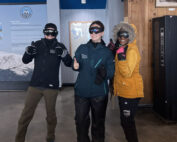Wildcat Mesonet Site Gets Upgrades
2016-01-09 09:57:19.000 – Roger Pushor, IT Specialist
The Wildcat mesonet site has been converted from 12 to 24 volts to help improve power performance and allow us to install a new Axis P5534 720p webcam donated by one of our supporters. We’ve also reconfigured the solar panels to a 24 volt photovoltaic array and added a maximum power point tracking (MPPT) charge controller, also donated by a generous supporter, for charging the batteries installed during the last week of December. These charge controllers are much more sophisticated than the old Xantrex, are built around a small imbedded computer to control the charging of the batteries, and also run a small webserver. This allows the PV array, battery, and charging information to be viewed remotely over the Internet. In our case, the first “hop” of that connection is over a nearly four and a half mile radio link.
So are we done at Wildcat? The answer to that question is no. When we first converted from a 12 to a 24 volt system we didn’t know we’d be getting an MPPT charge controller so we reconfigured our five 12 volt solar panels into two 24 volt banks, leaving one 12 volt Solar Panel unused. With the new MorningStar TS-MPPT-60, which doesn’t require the PV array voltage to match the battery bank voltage, we can “series up” all five 12 volt solar panels into a single string. This increases our ability to extend the charging cycle to earlier in the morning and later in the afternoon and most importantly on those not so sunny days we can still “harvest” some usable power to run our equipment and charge our batteries. I’m also in the process of completely revamping our power management routines for the Wildcat site. In the past, during a long stretch of cloudy or foggy weather, we had to turn off the radio links that gathered weather data from the Auto Road Vertical Profile (ARVP) sites and transmitted it to the summit through Wildcat. I’m now modifying that routine to only power up the radios for five to ten minutes at the top of each hour to gather the latest data and transmit it to the summit.
So why is the Wildcat site so important? All of our mesonet data and webcam images from remote sites have to be transmitted via line-of-site radio links. Even on a clear day the Sherman Adams building is not visible from the ARVP mesonet stations at 2300’, 3300’, 4000’, 4300’ and 5300’. Data from these sites must reach the summit, where our servers that process the data and disseminate it this website are located. When the mesonet and ARVP were designed over ten years ago, the best option was to make Wildcat a hub site that could collect data from the ARVP sites and retransmit it the nearly four and a half miles across Pinkham Notch to the summit. With EduTrips, Day Trips, and shift changes for the Observatory, shift changes for State Park, and Snow Coach trips for the Mt. Washington Auto Road, it’s important that everyone has current weather conditions from the ARVP sites.
We hope that these changes will make our persistent power problems at Wildcat ancient history. All of this work was done with minimal direct cost to the Observatory, thanks to the generosity of a couple our most dedicated members. Thank you David and Paul, your generosity, along with that from several thousand other members, is what helps keep the Observatory going so we can provide accurate and timely weather information to everyone who lives, works, and plays in the White Mountains of New Hampshire. A big thank you also goes to our colleagues at Wildcat who get us, and our equipment, up and down the mountain in the gondola in the warmer months and on the chair lift during ski season.
Roger Pushor, IT Specialist
Team Flags Return for Seek the Peak’s 25th Anniversary
Team Flags Return for Seek the Peak's 25th Anniversary By MWOBS Staff Mount Washington Observatory is looking forward to continuing a much-loved tradition for Seek the Peak’s 25th Anniversary: Team flags. In inviting teams
Meet Summer Interns Zakiya, Max and Maddie
Meet Summer Interns Zakiya, Max and Maddie By MWOBS Staff We are excited to welcome six teammates to the summit of Mount Washington this summer! During their internship, these students and graduates will play
Saying Goodbye to the Summit
Saying Goodbye to the Summit By Alexis George After an extraordinary last three years working as a Weather Observer and Meteorologist, I am excited to pursue a different career. As sad I as am




